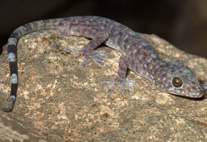Abstract
Colonial zoanthids are a conspicuous feature of the subtropical rocky intertidal in KwaZulu-Natal but those of the genus Zoanthus have a confused taxonomy with 10, difficult to separate, nominal species described from the region. This paper presents an analysis of polyp size, measured as mean diameter determined photographically from the number of polyps occupying an area of 6 × 4 cm2. The results, based on diameter frequency of 127 samples from five shores, indicate three populations (morphotypes) with means of 4.3 (SD ±0.53), 5.7 (SD ±0.70) and 8.4 (SD ±0.58) mm occurring in the approximate abundance ratios of 10:5:1, possibly corresponding to Zoanthus sansibaricus, Z. natalensis and Z. lawrencei. The underlying assumptions with regard to population structure (the number, size and degree of fragmentation of clones) and the normality of data are discussed, as are trans-oceanic larval dispersal, recruitment, and genetic connectivity. The essential, traditional species description in Zoanthus, using internal morphology, on its own may be an inadequate discriminator of species. The status of the few possibly valid species is discussed in relation to the present results and recent studies based on the application of molecular genetics. Thorough studies of the population structure (genets and ramets) and a taxonomic approach based on the combined use of morphology, genetic methods and statistically robust, quantitative morphometrics are proposed as a potential way forward.

